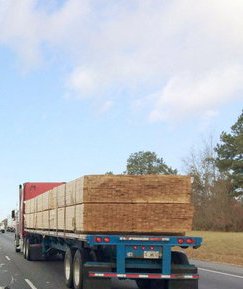FLATBED TRUCKING TERMS
Conestoga Trailer– A flatbed trailer equipped with a rolling tarp system that allows for faster, easier tarping of a flatbed or stepdeck load. Conestoga is actually a brand name of one such system but the term Conestoga trailer’ has come into generic use in theindustry. The system has a tarp stretched over a rolling frame that can be pushed to the front of the trailer allowing for the loading of the rear of the trailer. When pushed to the front, the tarp and frame resemble an oversized accordion. Once the rear is loaded, the system is pushed to the rear allowing the front of the trailer to be loaded.
Consignee– The party to whom a load will be delivered. Sometimes referred to as the receiver.
Corner Protectors – any of various devices ( normally somewhat ‘L shaped) use to prevent damage to edges and corners of bundles of cargo. They are typically placed underneath the chains and straps used to secure cargo.
Covered Wagon– See sidekit trailers.
Dry Van Trailer – See van trailer.
Dunnage – Material used in loading freight that will be unloaded by crane or forklift. It is typically lumber (either 2 x4 or 4×4) that is placed between bundles of lumber or steel. The dunnage provides a space between bundles that will allow a forklift blade to get underneath a bundle before lifting. Other materials such as steel or drywall strips are sometimes used for dunnage.
Exclusive Use– an agreement that the use of a trailer hauling a load is dedicated to one shipper. Freight belonging to other shippers will not be loaded on the trailer resulting in the trailer being devoted exclusively to the original shipper.
Legal Loads – Loads that are less than 8’6″ wide, 13’6″ high, and meeting the length requirements for the routes traveled.
LTL – abbreviation for less than truckload shipments. LTL shipments are shipments that are not full truckloads. As such, these partial loads can be combined with other shipments resulting in saving for all shippers involved.
Open Deck Trailers – a classification of trailers including flatbed, stepdeck and RGN trailers.
The trailers are used to transport items such as machinery, equipment, lumber, steel, drywall and construction materials. They are characterized by an open deck and the fact that they are not enclosed.
Overdimensional Loads– Flatbed, stepdeck or RGN loads that exceed allowable height, weight or length limits. Loads exceeding the legal limits can be transported but require permits granting authority to transport. While the permits grant authority, various restrictions will be placed on travel. These restrictions may affect hours of transport, routes for travel as well as flagging or marking of the load. Escort cars may also be required. Divisible loads will not be granted permits.
Oversize Loads – See Overdimensional loads
Partial Loads – Shipments that do not require use of all the deck space on a trailer. These shipments can be combined with other shipments resulting in reduced costs to ship freight. Same as LTL loads
Permit Loads– Also called permitted loads. This is another term for an overdimensional load.
Sidekit Trailers – a flatbed trailer equipped with either fiberglass or plywood panels mounted in a
vertical fashion giving a sidebody effect. This allows for the shipment
of loads that may not be crated or packaged. Examples of loads
transported in sidekits are watermelons, scrap metal, steel or aluminum
coils, and engine blocks. Sometimes these trailers are equipped with a
tarp and bow system designed to keep the freight dry.
A slang term for a sidekit trailer is a covered wagon. When viewed
from the rear, these rounded tarp systems remind one of the wagons used by pioneers.
Tarp – The term is short for tarpaulin. A tarp is a large piece of heavy vinyl fabric used on
flatbed, stepdeck and open deck trailer loads to protect the freight
from rain, snow and road grime. The term tarp is also used as a
verb to describe the act of using the tarp to cover a load.
V Boards – a type of flexible corner protector usually made from 2 pieces of 1 x4 lumber and nylon straps. They are often placed on the edges of brick cubes in order to keep the bricks securely inside the cube during transport.
Van Trailer – an enclosed trailer most readily identified by the fact that it has doors on the rear. Also known as box trailer or dry van.
©Copyright J C Nester Co., Inc 2009 All Rights Reserved
